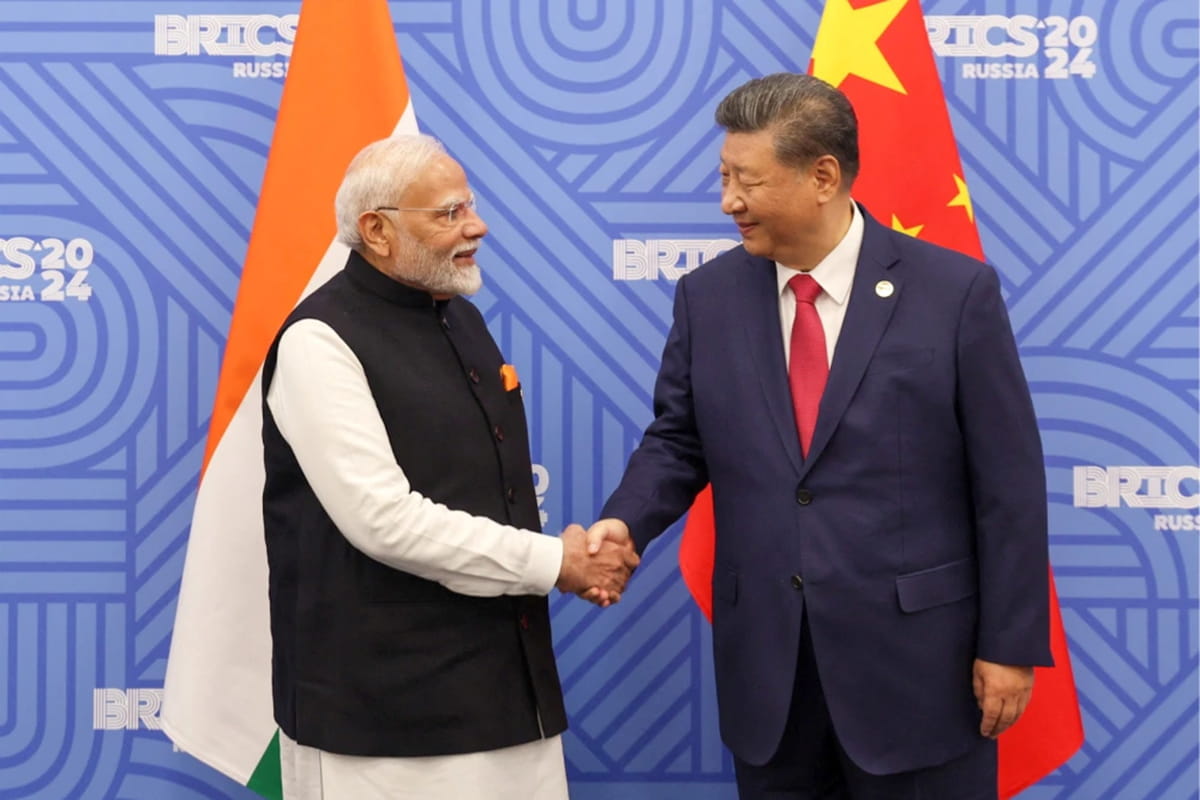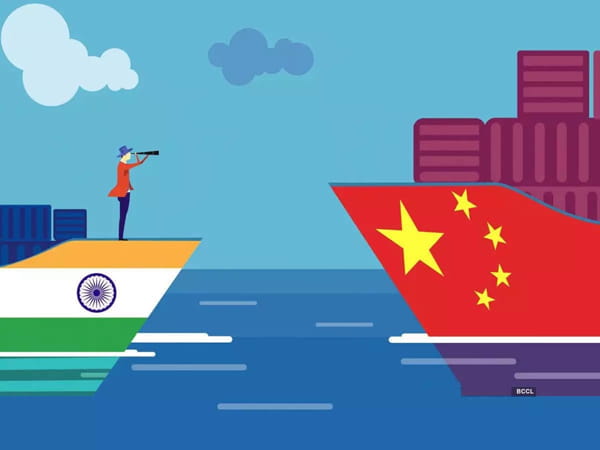
Indian Prime Minister Narendra Modi and Chinese President Xi Jinping at BRICS Summit, Kazan. | Ministry of External Affairs
India faces two potential pathways to capitalize on the "China plus one" strategy: deeper integration into China's supply chain or increased Chinese FDI into India. The latter appears more promising for enhancing India’s exports, particularly to Western markets. Encouraging Chinese companies to invest in India and export products to the US and Europe may prove more advantageous than relying solely on trade with China, especially given the growing trade deficit.
Introduction
The economic relationship between India and China stands as one of the most dynamic and complex in Asia, marked by significant trade volumes, investment opportunities, and geopolitical tensions. While China’s economy is growing at 5.0%,[1] India is the fastest-growing economy in the world, with a projected growth rate of 7.0%. This rapid growth makes India a critical driver of global demand moving forward. Hence, navigating this relationship requires a balance between leveraging economic opportunities and managing strategic tensions.
Trade Relations and Trade Deficit
The trade relationship between China and India is heavily weighted toward Chinese exports. In August 2024, China's exports to India reached $11.4 billion, while imports from India stood at just $1.3 billion, leading to a significant trade imbalance in China’s favour at $10.1 billion.[2] Between August 2023 and August 2024, China's exports to India increased by $1.4 billion (or 14%), rising from $10 billion to $11.4 billion, while India's imports from China declined by $290 million (or 18.3%), dropping from $1.59 billion to $1.3 billion.[3] This trend highlights the distinct comparative advantages between the two nations: China maintains a surplus in manufacturing, while India shows strength in services,[4] but struggles to consistently maintain a surplus in manufacturing.[5]
In August 2024, China's increased exports to India were driven primarily by a surge in the sale of Vinyl Chloride Polymers (up by $94.5 million or 247%),[6] flat panel displays (up by $68.2 million or 25.9%), and large flat-rolled stainless steel (up by $66.4 million or 62.1%). Meanwhile, India's decreased exports to China were largely attributable to declines in diamonds (down by $91.4 million or -67.3%), non-retail pure cotton yarn (down by $74.3 million or -95.3%), and refined petroleum (down by $39.8 million or -71.1%).[7] Another area of concern for India, is in the imports of critical minerals.[8] China accounts for 56% of India's total critical minerals imports.[9] Given this dependency, India is trying to diversify its sources and build partnerships such as the Minerals Security Partnership.[10]
India’s imports from China have historically been dominated by capital goods and intermediates. In 2018, about 50% of India’s imports from China consisted of capital goods (excluding transport equipment), followed by industrial supplies (45%) and consumer goods (8.2%). The top imports at the two-digit level included processed industrial goods and parts and accessories of capital goods. On the export side, India’s major exports to China in 2018 were industrial supplies (64% of total exports), goods (20%), and fuels and lubricants (18%).[11] Despite the growing concern in India over this escalating trade deficit, recent trends indicate that the gap may be narrowing.[12]
China's role as the “factory of the world” is well-known, with the country producing 31.6% of global manufacturing output[13] in 2024, accounting for 34% of manufactured goods globally.[14] India, ranked fifth globally in manufacturing, contributes 2.9% of global output. However, India has been climbing the ranks in global value chains (GVCs), with the share of GVC-related trade in its gross trade increasing from 35.1% in 2019 to 40.3% in 2022. This improvement is largely due to government efforts to reduce logistics costs and enhance trade facilitation, as evidenced by India's jump from 44th place to 38th in the World Bank’s Logistics Performance Index between 2018 and 2023.[15]China's GVC participation rate was 36.6% in 2018, with backward participation (i.e., foreign inputs in exports) at 19.3% and forward participation (domestic inputs in foreign exports) at 17.2%.[16] While each nation has pursued a unique path in its development journey, the foreign value added in Indian manufactured exports has never exceeded 12%, compared to China's peak of 25%.

Foreign Direct Investment
China's FDI in India remains minimal, with China ranking 22nd in terms of FDI inflow as of March 2024, contributing just 0.37% of India’s total FDI equity inflow, equating to approximately $2.5 billion since 2000. The geopolitical tensions between the two countries play a significant role in limiting Chinese investment in India. However, the Economic Survey[17] argues that increasing Chinese FDI in India could deepen India’s integration into GVCs, as other countries have done by lowering trade costs and facilitating investment.
The "China plus one" strategy, which involves diversifying supply chains to reduce reliance on China, presents an opportunity for India. Many companies, particularly in North America, have already started shifting production away from China to countries like Mexico, Vietnam, and Thailand. India, with its large domestic market, is also becoming an attractive destination for investment, particularly in smartphone manufacturing and assembly. India’s efforts to integrate into GVCs of developed countries have focused on sectors like renewable energy and advanced technologies such as semiconductors and artificial intelligence. Agreements such as the Australia-India Free Trade Agreement and the US-India Clean Energy Initiative are facilitating these efforts. India has seen growing exports of environmentally friendly technology, such as solar water heaters and wind turbines.
The BRICS group—comprising Brazil, Russia, India, China, and South Africa—plays a significant role in shaping economic relations between India and China. Shared membership in BRICS offers India and China opportunities for collaboration, particularly in trade and investment, notwithstanding the challenges.
India faces two potential pathways to capitalize on the "China plus one" strategy: deeper integration into China's supply chain or increased Chinese FDI into India.[18] The latter appears more promising for enhancing India’s exports, particularly to Western markets. Encouraging Chinese companies to invest in India and export products to the US and Europe may prove more advantageous than relying solely on trade with China, especially given the growing trade deficit.
Conclusion
The evolving trade relationship between India and China, while marked by a substantial imbalance, presents opportunities for strategic growth. India's burgeoning economy, coupled with its rising participation in GVCs and potential to benefit from the "China plus one" strategy, positions the country to further integrate into global markets. Yet, for India to fully capitalize on these opportunities, it will need to focus on enhancing foreign direct investment, improving logistical efficiency, and deepening its ties with both Western and Asian economies. While challenges remain, India's future in global trade looks promising.
(Exclusive to NatStrat)
Endnotes: